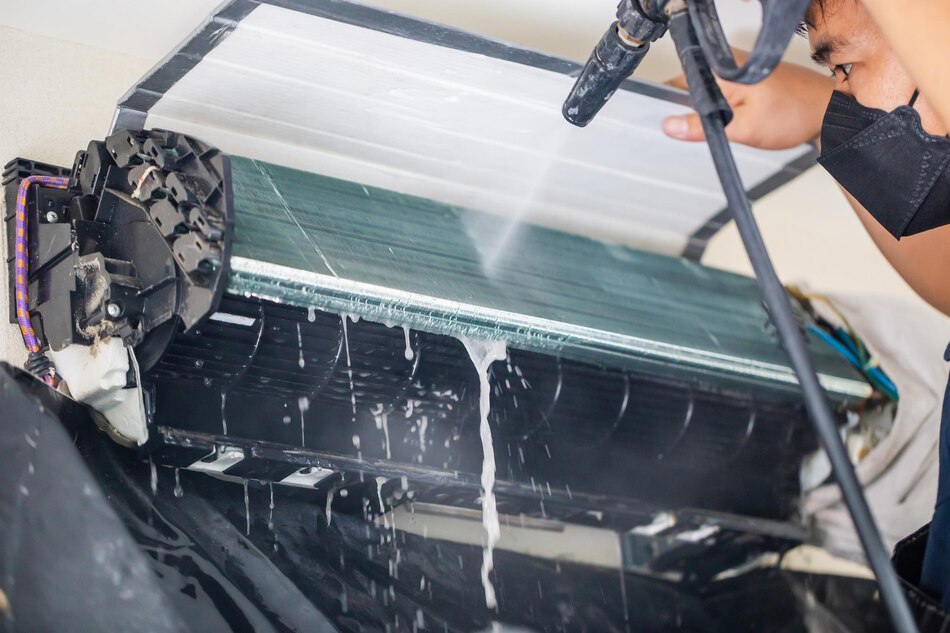When it comes to fan coil chemical cleaning, different aircon contractors offer various methods at different prices. The scope of work and charges can vary significantly. Let’s take a closer look.
For example, some companies offer chemical wash for as low as $60. This typically involves regular aircon servicing and applying a chemical solution on the filter and cooling coil. On the other end of the spectrum, local manufacturing agents charge between $180-$230 for a chemical overhaul. The significant price difference indicates distinct differences in the services provided.
The purpose of this article is not to critique the different types of chemical cleaning offered by aircon companies but rather to outline the scope of work involved in a chemical overhaul that aligns with the manufacturer’s recommended practice.
A chemical overhaul consists of several crucial steps to ensure proper cleaning and maintenance of the fan coil unit. Here is a detailed breakdown of the process:
- Pump Down and Lock: The first step is to pump the refrigerant gas into the condensing unit and lock service valve. This prevents any accidental leakage during the cleaning process.
- Disconnecting: Unsecure the flare jointing and disconnect the electrical wiring from the drainpipe at the fan coil unit. This allows for the safe removal and disassembly of the unit.
- Dismantling: Carefully dismantle the fan coil unit from wall or ceiling. This involves removing screws, bolts, or brackets that secure the unit in place.
- Component Removal: Once the fan coil unit is detached, dismantle components such as the electrical circuit board, drain pan, evaporator coil, fan motor, and fan blower. This step ensures thorough access to all parts for effective cleaning.
- Inspection: Inspect the electrical circuit board and motor fan for any signs of damage or burnt marks. Brush off any accumulated dust or debris from the surfaces.
- Chemical Washing: Move the disassembled parts to a designated washing area. Begin the chemical washing by applying a suitable cleaning solution to the evaporator coil, fan coil body, front cover, and fan blower. It is advisable to use alkaline chemicals instead of acidic ones as they are less corrosive and minimize the risk of damage.
- Flushing: After applying the cleaning solution, flush with water to remove dirt, grime, and residue. Injecting a chemical solution helps loosen and extract trapped dirt deep within the components.
- Thorough Rinse: Once the forming process is complete, thoroughly rinse all the parts with water to ensure the removal of any residual chemical solution.
- Drying and Reassembly: Dry all the cleaned parts, reassemble the fan coil unit. This includes reconnecting the electrical circuit board, evaporator coil, drain pan, fan motor, and fan blower.
- Drainpipe Clearance: Clean the drain piping system by flushing or vacuuming to ensure proper drainage and prevent clogs.
- Reinstallation: Install the fan coil unit back onto the wall or ceiling using the appropriate screws, bolts, or brackets. Secure the flare joint, reconnect the wiring and drainpipe.
- Vacuum Pump: Utilize a vacuum pump to remove any remaining air and foreign materials from the refrigerant piping system. This step ensures optimal performance and efficiency of the air conditioning system.
- Leak Check: Unsecure the service valve then carefully inspect for possible leakage at the fan coil flare jointing. Address any leaks promptly to prevent future issues.
- Testing: Finally, test run the aircon and check for accurate operating pressure to ensure the unit functions correctly.
Proper execution of the chemical overhaul process is crucial to maximize cleaning effectiveness and avoid potential problems such as corrosion, leakage, and damage to the air conditioning system. By following these steps aligned with the manufacturer’s recommended practice, you can ensure your fan coil unit’s longevity and optimal performance.
FAQs
Can a fan coil chemical overhaul improve air quality?
Yes, a fan coil chemical overhaul could improve air quality. Thoroughly cleaning the various components of the fan coil unit, such as the evaporator coil and drain pan, helps remove accumulated dirt, dust, and other contaminants that can negatively impact air quality. This can result in cleaner and healthier air circulating in your space.
How long does a fan coil chemical overhaul take to complete?
The duration of a fan coil chemical overhaul could vary depending on factors such as the size of the unit and the extent of cleaning required. On average, it can take anywhere from 2 to 5 hours to complete the entire process. However, for larger or more complex systems, it may take longer.
Is it necessary to have a fan coil chemical overhaul if the unit is functioning fine?
While regular servicing and maintenance are essential, a fan coil chemical overhaul provides a deeper level of cleaning and care that cannot be achieved through regular servicing alone. Over time, even if a unit appears to function fine, dirt and contaminants can accumulate within the internal components, potentially affecting performance and efficiency. Therefore, scheduling a periodic chemical overhaul is recommended for optimal maintenance.
Can I evacuate the premises during a fan coil chemical overhaul?
It is generally unnecessary to evacuate the premises during a fan coil chemical overhaul. However, there may be some noise and disruption during the process, so it’s advisable to plan accordingly. If there are any specific concerns or requirements, it’s best to discuss them with the aircon contractor beforehand.
Can a fan coil chemical overhaul fix the cooling issues with my air conditioning system?
A fan coil chemical overhaul primarily focuses on cleaning and maintaining the internal components of the fan coil unit. While it can help improve overall performance, it may not address underlying issues with the aircon system unrelated to dirt or contaminants. If you are experiencing cooling issues, it’s recommended that you consult with a professional aircon technician to diagnose and address the specific problem.

